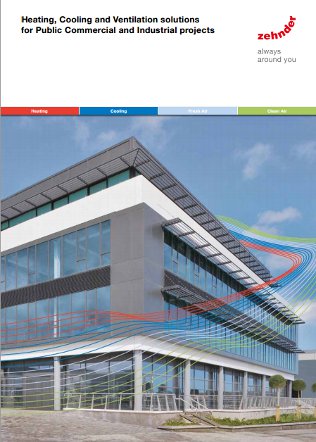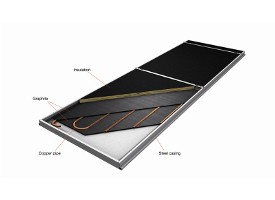Worrying new research reveals that 20% of building service engineers are unfamiliar with the UK Building Regulations’ Approved Document O, which addresses overheating in buildings - and almost half (46%) claim to understand the theory behind it but are unsure how to put it into practice.
The new study, commissioned by climate solutions specialist Zehnder Group UK in collaboration with CIBSE Journal, found that while a third (34%) of respondents claimed to know Part O ‘inside out’, the majority had a limited understanding – with 19% admitting they simply don’t understand it at all.
These concerning findings form part of a new report released that surveyed architects, consultants, developers and contractors, to get a better view of the understanding across the building industry when it comes to overheating.
Overheating is a real problem in residential buildings. When properties exceed a temperature threshold of 26°C for extended periods it can seriously affect occupant thermal comfort, health and wellbeing as well as productivity.

Currently the Climate Change Committee states that nearly one-fifth of UK homes already overheat, even during cool summers and it is reported that nine in 10 existing UK homes will be at risk of overheating if worldwide temperatures rise to 2°C above pre-industrial levels by 2050, if global warming continues on its current trajectory*.
The research found that despite this evidence of overheating risks, the topic ranked relatively low among the respondents’ list of priorities, with design, quality, building regulations, and energy efficiency coming out on top in new building projects – whereas modelling against the risk of overheating ranked eighth.
When asked what kept them up at night when planning a new building project, the top three concerns were design, cost and quality, with overheating being cited as sixth.
Jason Bennett, an indoor air quality expert at Zehnder Group UK, said: “The issue of overheating isn’t going to go away; it’s only going to get worse as climate change has more of an impact, heatwaves become more frequent and we continue to create highly energy-efficient homes that are effectively turning into ‘hot boxes’.
“When we create these energy efficient homes and high-rise apartment buildings of lightweight structural materials that are notorious for solar gains and lack thermal mass as well as greenhouse levels of glass, we end up spending a lot of money trying to reduce the temperature within those properties,” Bennett continued. “Whilst improved energy efficiency must continue to be a priority, the future has to be about cooling solutions to ensure comfort and improved health for building occupants.”
High-rise apartments were identified by 65% of respondents as the most at-risk buildings for overheating. However, a significant proportion raised concerns about schools (40%), care homes (39%), and hospitals (30%). All these building types cater for children and the elderly, who are among the most vulnerable in society.
Dr Anastasia Mylona, Technical Director of CIBSE commented: “It’s not surprising that one-fifth of the survey respondents lack awareness of Approved Document O. Many building service consultants and engineers do not encounter overheating due to the specialised nature of their roles. If you’re not doing overheating assessments, then you will not know a lot about Part O and how to comply with it.
“Engineers and consultants working in smaller teams are more likely to carry out Part O compliance calculations. It must be looked at in the context of the much lower level of awareness about overheating just a few years ago. Five or 10 years ago, nobody thought about it. That is a massive improvement that Part O has brought.”
Yet Zehnder believes this lack of understanding is ‘a worry’. Bennett counters that the 19% may include contractors who tend not to get involved with specifying overheating measures, but will include others that do. He says: “I would expect all the consultants, developers, specifiers and architects to know about Part O. These groups of professionals should be very familiar with Part O, which suggests that overheating should be more firmly embedded within the sector’s education curriculum. It’s all about education, education, education.”
While the level of understanding about Part O is concerning, knowledge of the causes of overheating in buildings was higher. The majority of respondents (78%) pointed to solar gain through increasing glazing as a primary cause, followed by unsuitable ventilation (45%), global warming (40%), inability to open windows (40%), and excessive insulation (39%).
When it comes to tackling overheating in buildings almost 8 in 10 (78%) actively prioritised passive cooling options, such as solar shading, optimised glazing and openable windows, over mechanical ones, with just 14% opting for the latter, reflecting the approach laid out in Part O.
Yet one respondent noted that mechanical cooling is ‘more predictable and dependable’, and another said, it is not always possible to rely on passive measures due to boundary constraints. For example, in highly urbanised areas such as central London, where noise and air pollution prevent window opening, recourse to mechanical ventilation and cooling is nearly inevitable.’
The survey findings underscore the need for a holistic and joined-up approach to buildings that incorporate robust strategies to mitigate overheating risks. This includes promoting better indoor air quality alongside cooling.
Bennett says: “Overheating needs to be designed out and thought about almost at the pre-planning stages. We have to look at the dynamics of the building and we need to be coordinating our efforts along the way - and not just us, as an indoor climate solutions manufacturer – we should be networking and coordinating with the others responsible for mitigating overheating risks.
“Mechanical cooling can be achieved with Air Conditioning, but this method is costly to run and recirculates air rather than replaces it with filtered air - and you would still need to ventilate the property. A better solution is to incorporate air temperation into an effective ventilation strategy, which is also required in line with Part F. The difference is fresh, clean air supply all year round with heat recovery in the winter and cooling in the hotter months – promoting better, healthy indoor air quality (IAQ).
“These systems are all cogs in the much larger machine of a home,” Bennett concludes. “I’d much rather have a ventilation system that was filtering particles rather than capturing them in my lungs. I can change the filters - I can’t change my lungs. If it can also keep my property cool, it’s a win-win.”












